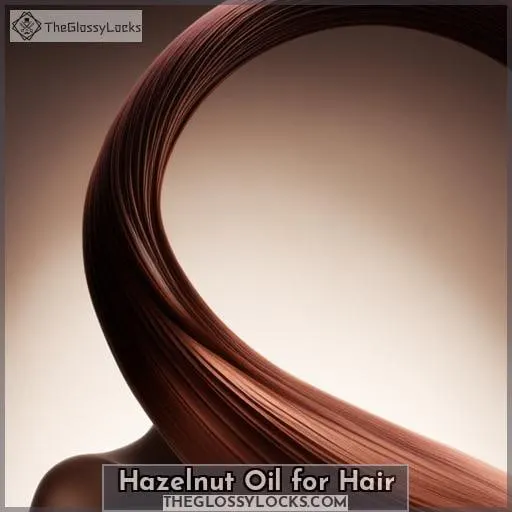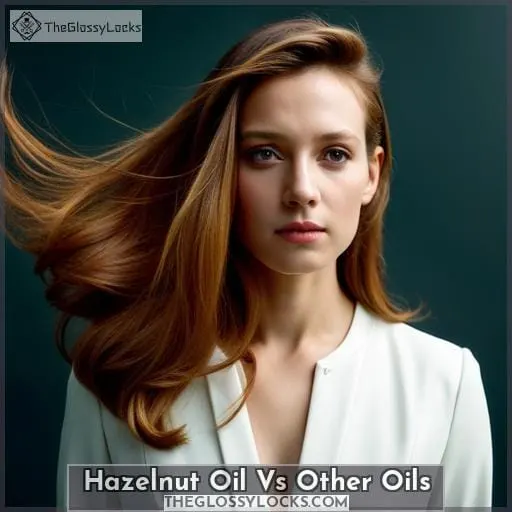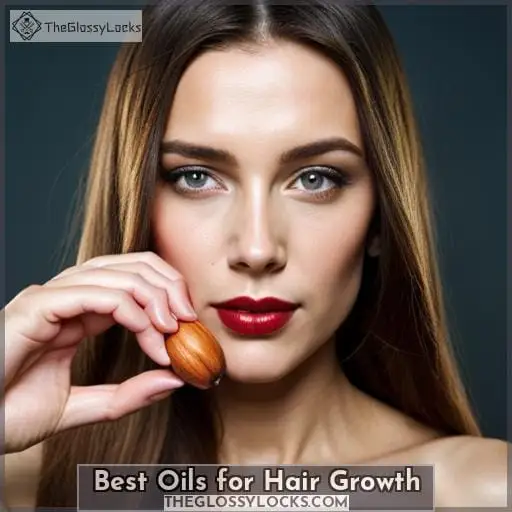This site is supported by our readers. We may earn a commission, at no cost to you, if you purchase through links.

She explains that bathing in the magical hazelnut oil lake will penetrate your hair shafts with vitamins and fatty acids, restoring a healthy shine from root to tip.
According to research, the oils’ small molecules can enter damaged areas of each strand, filling gaps and providing deep hydration.
In just one use, your hair bounces back to life.
So take the plunge – let hazelnut oil bring out the natural radiance of your hair.
Table Of Contents
Hair Type Considerations
Let’s consider how hair types influence beard oil formulation. Certain oils like hazelnut oil can penetrate the hair shaft to condition, while lighter oils provide surface moisture. Curlier ethnic hair may need more emollient oils to tame and soften the coarser texture.
Variations in hair texture influence the formulation of beard oils. Penetrating oils like hazelnut oil condition the hair shaft itself. Meanwhile, lighter oils hydrate the surface. Tightly coiled ethnic hair often benefits from richer oils that soften and smooth the coarse strands.
The hair’s structure impacts the oil blend. Oils that soak into the cortex, like hazelnut, condition from within. Lighter oils moisturize the cuticle. Kinky ethnic locks frequently require more emollient oils to gently relax the rigid coils.
Oils Penetrate Hair Shaft
How This Natural Ingredient Deeply Moisturizes and Repairs Hair
Your hair’s texture determines what oils can penetrate the shaft. Coconut oil’s small molecular structure allows it to enter the hair shaft. Other oils like olive seal the cuticle, making hair shiny. Oils like hazelnut nourish skin and hair.
- Oils penetrate hair shaft
- Coconut oil penetrates hair shaft
- Olive oil seals hair shaft
- Hazelnut oil nourishes skin and hair
- Lighter oils penetrate better
When you formulate oils for hair, it’s important to consider penetration versus coating. Lighter oils like coconut can enter the hair shaft for deep conditioning, while oils like olive coat the outside, sealing in moisture.
Nut oils provide nourishment. Blending penetrating and sealing oils tailors the formula to your hair goals.
– Light Oils Condition Beard
Your beard’s responsiveness to oils depends on its texture and curl pattern. Lighter oils like sunflower, argan, and meadowfoam can help condition and soften hair without weighing it down. Consider your beard’s coarseness and porosity when selecting oils. Oils like coconut can penetrate the shaft, while oils like olive coat the cuticle.
Test oils individually to see which ones help tame and smooth your beard the best.
– Jewish Beard Needs Moisture
As a man with a Jewish beard, consider using oils that provide deep moisture to soften the rough, curly texture. Jojoba, argan, and hazelnut oils can penetrate the hair shaft to condition. Try a blend of these oils to soften and tame your beard.
Hazelnut Oil for Hair
Continuing from hair type considerations, you’re about to learn how hazelnut oil deeply moisturizes and repairs your hair.
Hazelnut oil penetrates the hair shaft due to its small molecular size. Its fatty acid content helps nourish hair and add shine. Many find hazelnut oil moisturizes without clogging pores, making it a top choice for beards and scalps prone to acne.
When blended with lightweight oils like coconut, hazelnut oil makes an excellent addition to DIY hair treatments.
- Penetrates hair shaft
- Adds shine and softness
- Contains fatty acids
- Non-comedogenic properties
- Pairs well with coconut oil
The oil is known for its ability to penetrate the hair shaft. It helps add shine and softness. Hazelnut oil is effective at moisturizing without clogging pores. This makes it a great option for beards and scalps prone to acne.
Blended with oils like coconut, hazelnut oil is a great addition to DIY hair treatments.
fractionated coconut, argan, jojoba, hazelnut, sunflower, shine, soften, penetrate, acne, non-comedogenic
oils skin type, application technique, DIY recipe, brand comparison, buying tips
How to Apply Hazelnut Oil
Since hazelnut oil is rich in vitamins and fatty acids that nourish hair, apply a few drops to damp hair after showering. Then, massage it into your scalp and comb it through your hair to evenly distribute and deeply moisturize each strand.
- Focus on ends and scalp
- Warm it slightly before applying
- Leave it in overnight with a shower cap
- Add some to your conditioner or hair masks
- Use 1-2 times per week
- Massage your scalp to increase circulation
- Avoid roots if you have oily hair
- Rinse thoroughly if you have acne-prone skin
Apply to Wet or Dry Hair?
You can use hazelnut oil on either damp or dry hair for deep conditioning benefits.
| Wet Hair | Dry Hair |
|---|---|
| Better penetration | Less weigh down |
| Increased hydration | Works well for touch-ups |
| May need to rinse out | No need to rinse |
| Can use before styling | Good for split ends |
| Intense treatment | Light conditioning |
Some people find it’s best to use hazelnut oil on damp hair after showering for maximum moisturization. Others prefer to use it on dry hair as needed between washes to control frizz. Test to see if your hair responds better to wet or dry application.
In summary, hazelnut oil can be used on either wet or dry hair to provide deep conditioning benefits. On wet hair, it may penetrate better and provide more intense hydration, but may need to be rinsed out.
On dry hair, it provides lighter conditioning without weighed down hair. Some key factors are penetration, hydration, frizz control, and the need to rinse when applying to wet or dry strands.
How Often to Use Hazelnut Oil
You’ll want to use hazelnut oil 1-2 times per week for the best results. This gentle yet nourishing oil provides deep hydration without weighing hair down when used in moderation:
- Strengthens hair fibers
- Reduces split ends
- Adds shine
- Moisturizes scalp
- Controls frizz
Hazelnut oil is rich in fatty acids and vitamin E to nourish hair. Using it too frequently can make hair look greasy.
In moderation, hazelnut oil deeply conditions for stronger, smoother hair without weighing it down or causing greasiness.
Hazelnut Oil Vs Other Oils
Unlike other oils, hazelnut oil can deeply penetrate the hair shaft to nourish hair from within. Its light texture allows it to be quickly absorbed without leaving residue. Hazelnut oil contains vitamin E, antioxidants, and essential fatty acids that repair damage and leave hair strong and hydrated.
While coconut oil also penetrates the shaft, hazelnut oil is lighter and less likely to build up.
Ultimately, hazelnut oil stands out for its ability to be quickly absorbed while delivering nourishing vitamins deep into hair. For those seeking an oil that repairs damage throughout the hair shaft, hazelnut oil is an optimal choice.
Potential Downsides of Oils
Your hair’s luster may suffer if oils aren’t thoroughly rinsed out:
- Excess oil attracts dirt
- Can make hair limp
- May block follicles
- Clog pores on scalp
- Difficult to remove
Oils offer benefits but can also have downsides if overused or not washed out properly.
In summary, hazelnut oil can provide deep conditioning for dry, damaged hair with its fatty acids and vitamins. However, any oil can have drawbacks if not thoroughly cleansed from hair. Using oils judiciously allows maximizing their benefits for healthy, moisturized hair.
Choosing the Right Conditioner
When choosing a beard conditioner, consider using hazelnut oil. Research shows hazelnut oil can penetrate the hair shaft to deeply moisturize and repair. The oil’s light texture also helps soften rough beards without feeling heavy or greasy.
The nourishing vitamins and fatty acids in hazelnut oil promote healthy, soft beards by smoothing the hair cuticle and retaining moisture. Look for organic, cold-pressed hazelnut oil to get the highest quality and purity.
A few drops of hazelnut oil applied to damp beards and combed through adds shine while controlling frizz. For best results, allow the oil to soak in for a few minutes before rinsing out. Hazelnut oil’s luxurious feel makes it an ideal ingredient in homemade beard conditioning treatments too.
Oils Penetrate Hair Shaft
You’re choosing the right conditioner when selecting oils that penetrate the hair shaft like coconut, sunflower, and argan oils. These oils have small enough molecules to enter the hair cuticle and provide conditioning benefits.
Look for lightweight oils that won’t weigh hair down. A little goes a long way in nourishing hair from the inside out.
– Light Oils Soften Beards
Light oils soften beards.
You would moisturize a coarse beard by using light oils that can penetrate the hair shaft, such as sunflower, argan, and meadowfoam oils. These oils have smaller molecules that can absorb into the hair cuticle, thereby helping to soften and hydrate coarse facial hair.
Unlike oils that just coat the hair, penetrating oils provide lasting softness and protection.
– Essential Oils Scent Beard
Choosing an essential oil like lavender, sandalwood, or cedarwood will allow you to add a pleasant scent to your beard oil recipe. Just a couple drops of essential oil per ounce of carrier oil is all you need. Make sure to select an essential oil aroma your partner enjoys as well.
Daily Scalp Oiling Recommended?
Your scalp might benefit from daily oiling to moisturize and nourish hair follicles. Massaging oil into the scalp can increase blood circulation, which provides nutrients to support healthy hair growth.
Using lightweight oils like jojoba, grapeseed, or argan oil allows the scalp to absorb the oil without leaving residue. Oils with anti-inflammatory properties like coconut, tea tree, and peppermint can also help soothe irritation and reduce dandruff.
While daily oiling has benefits, it may not be necessary for all hair types. Listening to your scalp’s needs and scaling back on oiling if hair feels greasy is recommended. Overall, adding oils to your hair care routine can deeply condition, strengthen, and stimulate growth.
- Scalp oiling
- Hair follicles
- Increase blood circulation
- Lightweight oils
- Anti-inflammatory properties
- Soothe irritation
- Reduce dandruff
- Condition, strengthen
- Stimulate growth
scalp oil benefits, scalp oil frequency, lightweight scalp oils, anti-dandruff scalp oils, scalp massage technique
Best Oils for Hair Growth
When it comes to growing your hair, look to natural oils like coconut, olive, and avocado. Their fatty acids help moisturize hair follicles for growth. Massage warm oil onto your scalp to boost circulation.
Try a weekly deep conditioning treatment by leaving coconut or olive oil on overnight with a shower cap. Use lighter oils like grapeseed or jojoba if your hair is fine. Mix with essential oils like rosemary, peppermint, or lavender to stimulate.
Remember – oils alone won’t grow hair, but they can support healthy follicles when used properly.
Conclusion
Research shows hazelnut oil can deeply penetrate the hair shaft due to its small molecule size. As you massage hazelnut oil into your hair, its fatty acids and vitamins A, E, and K are absorbed, moisturizing and repairing damage from within.
Using hazelnut oil leaves hair looking smoother, shinier, and healthier. Though more studies are needed, initial findings suggest hazelnut oil may strengthen and protect hair more effectively than other oils that merely coat the strands.













